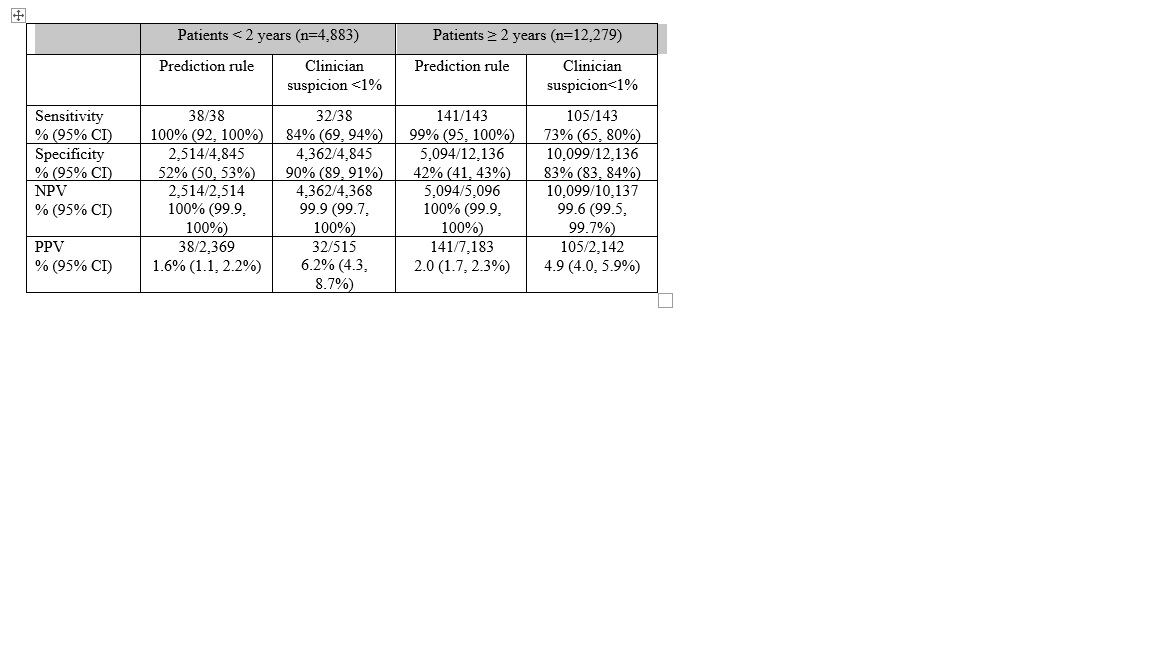Emergency Medicine: All Areas
Category: Abstract Submission
Emergency Medicine II
49 - Clinical Suspicion Compared to PECARN Prediction Rule for Clinical Important Traumatic Brain Injury (ciTBI) in Pediatric Patients with Minor Blunt Head Trauma.
Friday, April 22, 2022
6:15 PM - 8:45 PM US MT
Poster Number: 49
Publication Number: 49.104
Publication Number: 49.104
Kenneth Yen, University of Texas Southwestern Medical School, Dallas, TX, United States; Paul Ishimine, UC San Diego, San Diego, CA, United States; Pradip P. Chaudhari, Children's Hospital Los Angeles, Los Angeles, CA, United States; Mohamed Badawy, UT Southwestern Medical Center, Dallas, TX, United States; Nisa S. Atigapramoj, University of California, San Francisco, School of Medicine, San Francisco, CA, United States; Irma Ugalde, McGovern Medical School at the University of Texas Health Science Center at Houston, Houston, TX, United States; James F. Holmes, University of California, Davis, School of Medicine, sacramento, CA, United States; Nathan Kuppermann, University of California, Davis, School of Medicine, Sacramento, CA, United States
.jpg)
Kenneth Yen, MD
Professor of Pediatrics
University of Texas Southwestern Medical School
Plano, Texas, United States
Presenting Author(s)
Background: The Pediatric Emergency Care Applied Research Network (PECARN) traumatic brain injury (TBI) prediction rules identify children at very low risk of clinically important (ci) TBI. For a prediction rule to be useful, it should perform as good or better than clinician suspicion.
Objective: Our objective was to compare the test characteristics of clinician suspicion for ciTBI with the test characteristics of the PECARN prediction rules for ciTBI
Design/Methods: We analyzed clinicians’ suspicion of ciTBI in a prospective multicenter cohort study of children ( < 18 years) with minor blunt head trauma (GCS 14-15). Degree of clinician suspicion was documented as < 1%, 1-5%, 6-10%, 11-50%, or >50%. ciTBI was defined as death from the TBI, neurosurgery, intubation for ≥ 24 hours, or hospitalization for ≥2 nights for the TBI. We compared test characteristics with 95% confidence intervals (CI) of clinician suspicion ≥ 1% of ciTBI versus the presence of at least one PECARN prediction rule variable present.
Results: Clinician suspicion was analyzed for 4,883/4,912 (99%) patients < 2 years and 12,279/12,331 (99%) ≥2 years. In those < 2 years with clinician suspicion < 1%, CTs were obtained in 623/4,368 (14% 95% CI 13, 15%) with the most frequent reasons: young age=272, severe mechanism=168, and scalp hematoma=140. In those ≥2 years with clinician suspicion < 1%, CTs were obtained in 2,476/10,137 (24%, 95% CI 24, 25%) with the most frequent reasons: severe mechanism=905, loss of consciousness=660, and vomiting=493. The Table displays comparisons of clinician suspicion and prediction rule characteristics for identifying ciTBI. In the 44 patients with ciTBI and suspicion < 1%, 3 (7%) had craniotomy.Conclusion(s): The PECARN ciTBI prediction rules had a significantly higher sensitivity but lower specificity than clinician suspicion. The higher specificity of suspicion, however, did not translate into lower CT rates for those very low risk for ciTBI.
Comparisons of clinician suspicion and prediction rule characteristics for identifying ciTBI. In
Objective: Our objective was to compare the test characteristics of clinician suspicion for ciTBI with the test characteristics of the PECARN prediction rules for ciTBI
Design/Methods: We analyzed clinicians’ suspicion of ciTBI in a prospective multicenter cohort study of children ( < 18 years) with minor blunt head trauma (GCS 14-15). Degree of clinician suspicion was documented as < 1%, 1-5%, 6-10%, 11-50%, or >50%. ciTBI was defined as death from the TBI, neurosurgery, intubation for ≥ 24 hours, or hospitalization for ≥2 nights for the TBI. We compared test characteristics with 95% confidence intervals (CI) of clinician suspicion ≥ 1% of ciTBI versus the presence of at least one PECARN prediction rule variable present.
Results: Clinician suspicion was analyzed for 4,883/4,912 (99%) patients < 2 years and 12,279/12,331 (99%) ≥2 years. In those < 2 years with clinician suspicion < 1%, CTs were obtained in 623/4,368 (14% 95% CI 13, 15%) with the most frequent reasons: young age=272, severe mechanism=168, and scalp hematoma=140. In those ≥2 years with clinician suspicion < 1%, CTs were obtained in 2,476/10,137 (24%, 95% CI 24, 25%) with the most frequent reasons: severe mechanism=905, loss of consciousness=660, and vomiting=493. The Table displays comparisons of clinician suspicion and prediction rule characteristics for identifying ciTBI. In the 44 patients with ciTBI and suspicion < 1%, 3 (7%) had craniotomy.Conclusion(s): The PECARN ciTBI prediction rules had a significantly higher sensitivity but lower specificity than clinician suspicion. The higher specificity of suspicion, however, did not translate into lower CT rates for those very low risk for ciTBI.
Comparisons of clinician suspicion and prediction rule characteristics for identifying ciTBI. In

